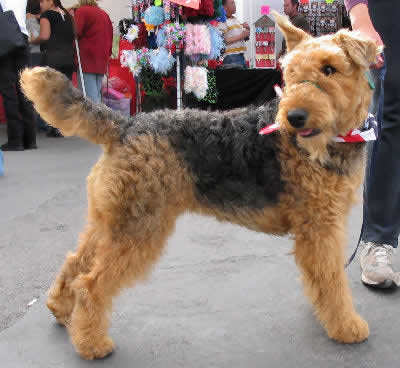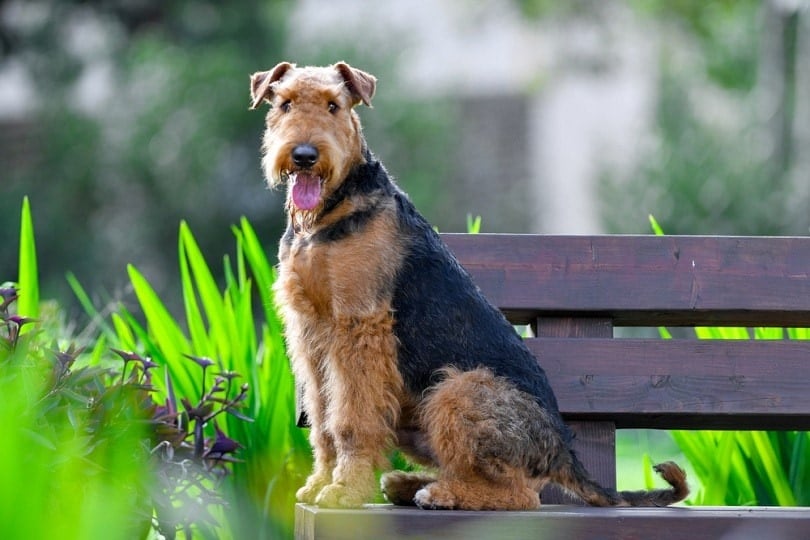
Originally bred to hunt and now often trained as a guard dog, the Airedale Terrier is lively and intelligent, so can play a bit rough with small children.
The Airedale’s versatility and high energy are two of its most popular characteristics. They are naturally protective of their owners, making them excellent guard dogs requiring minimal training. They can do well with children as well as other household pets if they are properly trained and socialized, however they are often dominent among other dogs.
When selecting an Airedale Terrier, one should make sure that his eyes are dark and small, his nose black and fairly prominent, his bite reasonably level. His hindquarters should not droop, his legs should be straight and well toned, and his coat should be thick and stiff.
- Kingdom: Animalia
- Phylum: Chordata
- Class: Mammalia
- Order: Carnivora
- Family: Canidae
- Genus: Canis
- Species: lupus familiaris
Common Name(s)
Airedale Terrier, Airedale, Waterside Terrier, King of Terriers
Breed Type
The Airedale Terrier originated as a hunting breed, but today is often trained as a guard dog due to its protective nature. It is generally quite active and intelligent, and may be aggressive toward other animals.
Background
Development of Airedales began in the mid-nineteenth century in the Yorkshire area. Bred to hunt otters, the Airedale is thought to be descended from the otter hound and the Old English Black-and-Tan Terrier. Known for their versatility, Airedales have also functioned as working and service dogs, as well as excelling in obedience and agility competition.
Description
Adult male Airedales are usually fairly muscular and just under two feet tall at the shoulder, with females measuring slightly shorter. Weight ranges are 50-65 pounds for males and 40-45 pounds for females. Airedales are black and tan in color, with some red in the black areas of some dogs and possible white markings on the chest. Life expectancy is up to 12 years.
Care and Feeding
Airedales tend to enjoy foods that contain lamb and rice. They are prone to dry skin, and supplementing their diets with certain oils can provide relief. Airedales are prone to hip dysphasia, but it is thought that starting them on adult food at an early age can help prevent it.
Lots of grooming is required for this breed. At minimum, they should be brushed daily to remove dead hair since they do not shed. Many owners also have their dogs clipped to achieve the distinctive Airedale shaping. Show dogs should be stripped and trimmed regularly. Bathing and grooming every two to eight weeks is advisable. It is customary in the United States to dock the Airedale’s tail no more than five days after birth.
Airedale Terriers will need annual checkups, and vaccinations as follows::
- 6-8 weeks: Distemper, Leptospirosis, Hepatitis, Parainfluenza, Parvo, and Corona virus (DHLPPC)
- 10-12 weeks: Second DHLPPC
- 14-16 weeks: Third DHLPPC and rabies
- Annually: DHLPPC and rabies booster
Airedales do not shed, so they are not hard to clean up after.
Housing Your Dog
Airedales need plenty of space due to their size and high activity level. They are quite active both indoors and out, so they are not good apartment dogs. They do, however, prefer to live indoors as long as you take them out for walks and to play frequently.
An Airedale can be crate trained, and they are often happy to sleep in their crates. As long as he has enough space and a comfortable place to lay, where your Airedale should sleep is a matter of preference.
Social Behaviors
If properly trained, Airedales can do well with children. However, they play rather roughly, so other breeds may be better for a small child. While the Airedale is often dominant among other dogs, it can generally get along with other household pets if it is socialized with them.
Handling and Training
Airedales are very intelligent, and they catch on quickly when training. But they also have minds of their own, and may become bored with repetition. Flexibility and variety are musts when attempting to train an Airedale.
Activities
Airedales need plenty of exercise. Ideally, they should have a large yard to play in for an hour or more each day. They tend to jump a lot, especially when young, and they enjoy chasing unfamiliar animals.
Breeding/Reproduction
When breeding Airedales, it is important to have hip x-rays done beforehand. These should be certified by the Orthopedic Foundation for Animals. You should also have the dog’s eyes checked by a Veterinary Ophthalmologist, and select a mate for your dog that has qualities that are as close as possible to Breed Standards.
Common Health Problems
Airedales are a generally healthy breed, but they may develop eye problems, hip dysplasia, or skin infections. Skin problems can often be prevented with a diet rich in fatty acids. Hip dysphasia is linked to heredity, so be sure to ask the breeder if a puppy’s parents have had any hip problems.
Availability
Airedale Terriers are fairly easy to find. There are breeders throughout the country, and you can probably locate one near you on the web. Costs for puppies average between $400 and $600.
References
- Animal-World References: Dog Breeds
- “Airedale Terrierâ€, Dog Breed Info Center, Copyright 1998-2008
- Dowd, Kathy, “Airedale Terriers“, Copyright 1997-2003, Referenced online, 2008
- Welton, Michelle, “Airedale Terriers: What’s Good About ‘Em? What’s Bad About ‘Em?â€, Copyright 2000-2008
- “The Versatile Airedaleâ€, The Airedale Clube of America, Inc., Copyright 1997-2008
- “Airedales Need Groomingâ€, Airedale Terrier Rescue and Adoption, Copyright 2008
- “Airedale Terrier Breed Standardâ€, American Kennel Club, Copyright 2008
- “Dog Vaccination Scheduleâ€, Greenbrier Veterinary Hospital, Copyright 1999-2002, Referenced online, 2008
Featured Image Credit: PROMA1, Shutterstock
